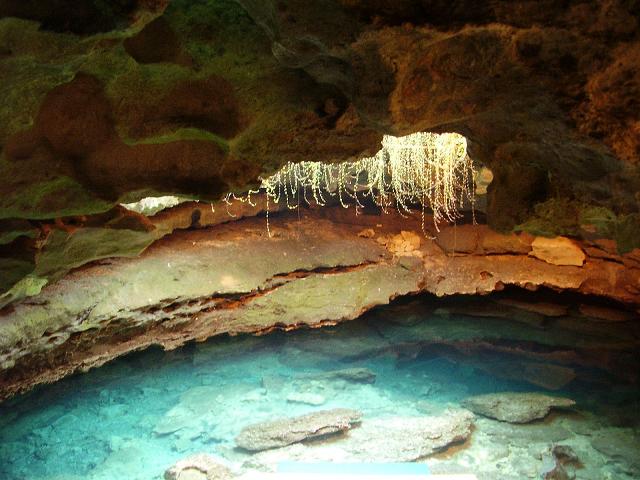Devil's Den (cave) on:
[Wikipedia]
[Google]
[Amazon]
 Devil's Den is formed by a karst window, in which the roof over a
Devil's Den is formed by a karst window, in which the roof over a
Devil's Den Spring homepage
Archaeological sites in Florida Caves of Florida Landforms of Levy County, Florida Williston, Florida {{LevyCountyFL-geo-stub
subterranean river
A subterranean river is a river that runs wholly or partly beneath the ground surface – one where the riverbed does not represent the surface of the Earth. It is distinct from an aquifer, which may flow like a river but is contained within a pe ...
has collapsed, exposing the water to the open surface, near Williston, Florida
Williston is a city in Levy County, Florida, United States. As of the 2010 census it had a population of 2,768.
Histoy
The city was established before 1885 by J.M. Willis, who named it after himself.
Geography
Williston is located at (29.38 ...
. It is privately owned, and operated as a SCUBA diving
Scuba diving is a mode of underwater diving whereby divers use breathing equipment that is completely independent of a surface air supply. The name "scuba", an acronym for "Self-Contained Underwater Breathing Apparatus", was coined by Chri ...
training and recreational facility.
The water in the underground river is a constant degrees. In cold weather water vapor rising from the surface of the river forms a visible plume above the entrance to the cave, which suggested a chimney from Hell to early settlers. The opening to the surface was originally a small solution sinkhole, through which visitors had to squeeze to reach the water. The opening was enlarged in the 1990s to ease access. The cave expands below water level (a shape described as an "inverted mushroom") to up to across. The maximum depth of the cave reaches 54 ft/16.5 m with the surface diameter being 120 ft. The water level in the cave has fallen along with the water table
The water table is the upper surface of the zone of saturation. The zone of saturation is where the pores and fractures of the ground are saturated with water. It can also be simply explained as the depth below which the ground is saturated.
Th ...
in the area. However, as of 2018 the water level has risen above the main stage/platform. The cave was opened to the public as a dive site in the early 1990s.
Four underwater passages extend from the pool under the opening, from to under the surface of the water. The passage called chamber 3, under water, contained animal and human remains and artifacts. The animal remains, which appeared to be associated with the human remains and artifacts, were from extinct (Pleistocene
The Pleistocene ( , often referred to as the '' Ice age'') is the geological epoch that lasted from about 2,580,000 to 11,700 years ago, spanning the Earth's most recent period of repeated glaciations. Before a change was finally confirmed ...
) species, including mastodon
A mastodon ( 'breast' + 'tooth') is any proboscidean belonging to the extinct genus ''Mammut'' (family Mammutidae). Mastodons inhabited North and Central America during the late Miocene or late Pliocene up to their extinction at the end of th ...
s, ground sloth
Ground sloths are a diverse group of extinct sloths in the mammalian superorder Xenarthra. The term is used to refer to all extinct sloths because of the large size of the earliest forms discovered, compared to existing tree sloths. The Cari ...
s, camel
A camel (from: la, camelus and grc-gre, κάμηλος (''kamēlos'') from Hebrew or Phoenician: גָמָל ''gāmāl''.) is an even-toed ungulate in the genus ''Camelus'' that bears distinctive fatty deposits known as "humps" on its back. ...
s, horse
The horse (''Equus ferus caballus'') is a domesticated, one-toed, hoofed mammal. It belongs to the taxonomic family Equidae and is one of two extant subspecies of ''Equus ferus''. The horse has evolved over the past 45 to 55 million ...
s, dire wolves
The dire wolf (''Aenocyon dirus'' ) is an extinct canine. It is one of the most famous prehistoric carnivores in North America, along with its extinct competitor ''Smilodon''. The dire wolf lived in the Americas and eastern Asia during the Lat ...
, bog lemmings, Florida spectacled bears, saber-toothed cat
Machairodontinae is an extinct subfamily of carnivoran mammals of the family Felidae (true cats). They were found in Asia, Africa, North America, South America, and Europe from the Miocene to the Pleistocene, living from about 16 million until ...
s, and peccaries
A peccary (also javelina or skunk pig) is a medium-sized, pig-like hoofed mammal of the family Tayassuidae (New World pigs). They are found throughout Central and South America, Trinidad in the Caribbean, and in the southwestern area of No ...
. The human remains have been dated to about 7,500 BC.
References
External links
Devil's Den Spring homepage
Archaeological sites in Florida Caves of Florida Landforms of Levy County, Florida Williston, Florida {{LevyCountyFL-geo-stub